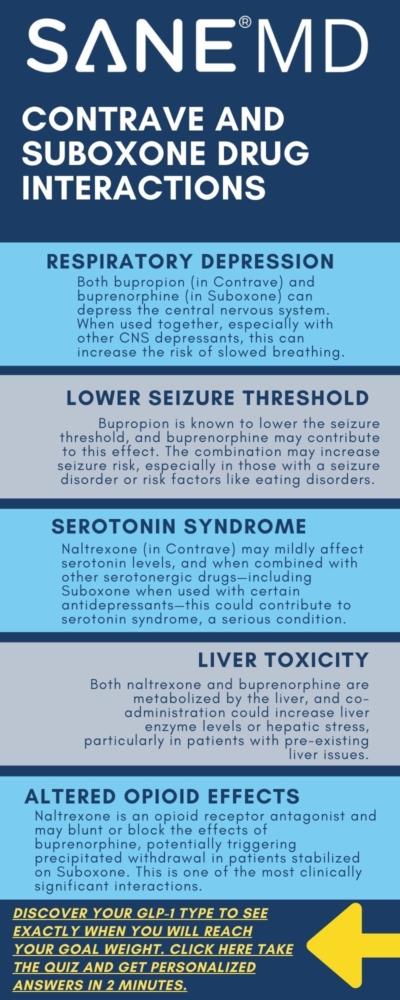Contrave and Suboxone Drug Interactions: Dangerous Combo?
Dr. Matthew Olesiak, MD, is the Chief Medical Director at SANESolution, a renowned wellness technology company dedicated to providing evidence-based solutions for optimal living. Dr. Olesiak earned his medical degree from the prestigious Jagiellonian University Medical College in Kraków, Poland, where he developed a strong foundation in medicine.

Combining medications always requires caution, especially when the drugs affect the brain’s reward system, metabolism, and pain pathways. Contrave and Suboxone are both powerful prescription treatments used for different health conditions—weight loss and opioid dependence, respectively—but their effects can overlap in ways that may not be safe.
This article explores the potential Contrave and Suboxone drug interactions, breaking down what you need to know about risks, symptoms, and how to talk to your doctor if you’re currently prescribed or considering treatment with either of these drugs.
Key Takeaways
- Combining Contrave and Suboxone may increase the risk of central nervous system depression, seizures, withdrawal symptoms, and liver stress.
- These two medicines should not be used together without close monitoring by a healthcare provider familiar with both.
- People with mental health conditions, eating disorders, or a seizure disorder face a higher risk when using either medication, especially in combination.
Understanding Contrave and Suboxone
Contrave is an FDA-approved combination of bupropion (also known by the brand Wellbutrin SR) and naltrexone, used to support weight loss in certain adults with obesity or weight-related health conditions. It works by acting on areas of the brain involved in hunger and cravings.
Suboxone, on the other hand, is a combination of buprenorphine, a partial opioid agonist, and naloxone, an opioid antagonist. It’s prescribed to treat opioid dependence and manage opioid withdrawal.
Both drugs act on the brain’s chemical systems, and both involve extended release tablets in some formulations, which can complicate timing and dosing when used together.
Why This Combo May Be Risky
Combining Contrave and Suboxone may result in complex and potentially harmful drug interactions due to the way each medication affects the brain, liver, and central nervous system. Both drugs are prescribed for serious health conditions—weight loss and opioid dependence, respectively—but when taken together, they can produce unpredictable side effects. The interaction can alter blood pressure, increase the chance of liver problems, heighten the risk of seizures, and trigger dangerous withdrawal symptoms or mental health conditions.
Below are the most concerning risks associated with taking these two medicines at the same time.
1. Central Nervous System Depression
While bupropion, one of Contrave’s main ingredients, is typically a mild stimulant used to treat depression, Suboxone contains buprenorphine, which has sedative properties that can suppress the central nervous system. When used together, the push-pull effect on brain activity can cause a rollercoaster of symptoms—some individuals may feel overly stimulated, while others experience profound drowsiness, confusion, or even episodes of dissociation. It’s important to note that taking opioids like morphine or codeine with Contrave can have the same effect on the central nervous system.
In rare cases, this combination may lead to impaired motor control or slowed breathing, especially if other medications or alcohol are also in the system.
“Mixing medications that target the brain’s dopamine and opioid receptors increases the complexity and risk. It’s not something patients should attempt without close supervision,” says Dr. Matthew Olesiak, MD, Chief Medical Director at SANE MD.
These neurological effects may be magnified in older adults or anyone with mental health conditions, a history of depression, or sensitivity to psychiatric medications. Always consult your doctor before combining Contrave with any other drugs affecting the nervous system.
2. Seizure Risk
Contrave may increase the risk of seizures, particularly in individuals with a seizure disorder, eating disorders, or those who drink alcohol regularly. Bupropion alone has a known dose-dependent seizure risk, which is why it’s often contraindicated in individuals with predisposing factors. Meanwhile, Suboxone can occasionally lower the seizure threshold, although this is a rare side effect.
When combined, these effects may increase the risk of neurological instability, especially during treatment initiation or dosage changes.
Many studies, including one published by the Canadian Medical Association Journal (CMAJ), found strong evidence that bupropion can lower the seizure threshold, making a seizure more likely.
This concern is heightened during opioid withdrawal, when the brain is already under stress from chemical fluctuations. Symptoms such as muscle twitching, disorientation, or unusual tiredness should be reported to your healthcare provider immediately.
Patients who are also on other medications that affect the brain may face a higher risk of complications.
3. Liver Strain
Both Contrave and Suboxone are metabolized through the liver, and prolonged or combined use can increase the workload on this vital organ. Contrave may increase the risk of liver damage, especially when used in patients who drink alcohol or are taking other medications processed by hepatic enzymes. Suboxone has also been linked to elevated liver enzymes, indicating potential stress or damage.
Taking the two together may compound the toxic burden, resulting in serious complications over time.
Symptoms of liver problems include:
- Dark urine
- Pale stools
- Unusual tiredness
- Skin rash
- Pain in the upper right abdomen
Indeed, a study published in the Annals of Pharmacotherapy demonstrated that Suboxone can elevate liver enzymes, especially when taken intravenously, potentially causing liver damage.
Individuals with pre-existing medical conditions like hepatitis, fatty liver disease, or those who take over-the-counter pain relievers frequently are especially vulnerable.
If you develop any of these symptoms, you should seek medical attention without delay.
4. Risk of Precipitated Withdrawal
One of the most serious dangers of combining Contrave and Suboxone is the possibility of precipitated withdrawal—a sudden onset of severe opioid withdrawal symptoms triggered by naltrexone, which blocks opioid receptors.
If a patient is still physically dependent on opioids or currently taking Suboxone, the presence of naltrexone can override the stabilizing effects of buprenorphine, resulting in immediate and intense withdrawal symptoms.
These symptoms may include:
- Muscle aches
- Chills and sweating
- Vomiting or diarrhea
- Mood swings or irritability
- Anxiety or suicidal thoughts
This effect not only causes immense discomfort but may also lead to relapse in individuals trying to overcome opioid dependence. That’s why most healthcare providers require a full detox period before starting Contrave in any patient with a history of opioid use. Skipping this step can increase the risk of a life-threatening situation, particularly in unsupervised settings.
5. Overlapping Side Effects and Mental Health Impact
Each medication carries its own risk profile for psychiatric symptoms, but the risks may multiply when they’re taken together. Both drugs can affect mood and cognition—Contrave may contribute to anxiety, irritability, or suicidal thoughts, while Suboxone has been associated with emotional blunting and, in some cases, false beliefs or paranoia. It’s important to note that taking Contrave with Buspar can also trigger anxiety and other side effects.
For patients with a history of depression, bipolar disorder, or other mental health conditions, the combination may destabilize mood regulation and cloud judgment.
Additional overlapping side effects include:
- Low blood sugar, especially in patients with diabetes
- Unusual tiredness or lethargy
- Nausea and gastrointestinal discomfort
- Persistent skin rash
- Confusion or hallucinations
These effects can be exacerbated by high-fat meals, polypharmacy (use of multiple other medications), or underlying medical conditions like liver damage or seizure disorders. Monitoring these signs closely during the first few weeks of treatment is crucial, especially for older adults or any vulnerable age group.
Important Considerations Before Taking Contrave with Suboxone
Before starting any new treatment, especially involving prescribed medications like Contrave and Suboxone, it’s essential to understand how the combination may affect your body. Both drugs are powerful and act on different systems, but when used together without proper oversight, the risk of complications increases substantially.
Below are the critical steps you should take to stay safe and avoid potentially serious health issues.
Talk to Your Doctor First
Never combine Contrave with Suboxone—or any other medications—without first discussing it thoroughly with your doctor or healthcare provider. This step is vital because your provider will evaluate the full picture of your medical conditions, lifestyle, and past medication use to identify potential drug interactions or health risks.
Some of the factors your provider will review include:
- Your history of seizures or seizure disorder
- Whether you drink alcohol regularly
- Any mental health conditions, such as bipolar disorder or depression
- Use of over-the-counter supplements, herbs, or other drugs
- Past experience with opioid withdrawal or opioid dependence
- Current or recent use of CNS-active agents such as sedatives, stimulants, or other antidepressants
“The risk isn’t just theoretical—it’s well documented. When prescribing Contrave, I ask about current or past use of opioid antagonists, mood stabilizers, and any other CNS-active drugs,” says Dr. Olesiak.
This conversation is especially important if you’re considering starting Contrave while still on Suboxone or recovering from opioid use. You may need to taper off Suboxone completely before it’s safe to begin a reduced-calorie diet supported by Contrave.
Read the Medication Guide Thoroughly
Every patient should carefully read the medication guide included with both Contrave and Suboxone. These documents outline crucial safety warnings, side effects, dosing schedules, and specific health conditions that may increase the risk of complications. For example, high-fat meals can alter how extended-release Contrave tablets are absorbed, potentially leading to adverse reactions. Similarly, starting Contrave without understanding the presence of naltrexone—a potent opioid antagonist—can result in life-threatening withdrawal symptoms if you’re still dependent on opioids.
Don’t rely solely on internet forums or anecdotal advice. Follow the prescribing information, ask your doctor questions, and make sure you fully understand both medications before combining them.
Watch for These Symptoms
Once you begin taking either medication—or both under medical guidance—you should monitor your body closely for warning signs.
The following symptoms may signal a serious allergic reaction, liver problems, or central nervous system issues, and could indicate that your body is not tolerating the drug interactions well:
- Dark urine or pale stools (potential signs of liver damage)
- A persistent or spreading skin rash
- Sudden onset of withdrawal symptoms, such as shaking, sweating, or intense cravings
- Shortness of breath or difficulty breathing (may signal a serious allergic reaction)
- Chest tightness or pain (could point to a rare but possible heart attack)
- Severe mood changes, aggressive or unusual behavior
- Confusion, hallucinations, or false beliefs
These symptoms should never be ignored. If you experience one or more, especially in the early stages of treatment, seek emergency help or contact your healthcare provider immediately. Delayed action could result in worsening of the condition or long-term harm.

Common Conditions That May Increase the Risk
You may face an increased risk of complications if you:
- Have a seizure disorder
- Are currently detoxing from opioids
- Are trying to quit smoking
- Take other antidepressants
- Have diabetes and are managing low blood sugar
- Follow a reduced calorie diet with high fat meals
- Are dealing with bipolar disorder
- Use over the counter pain relievers or other medications
What to Tell Your Healthcare Provider
Be transparent about:
- All medications (including other drugs and supplements)
- Whether you plan to stop taking Contrave
- If you have a history of mental health conditions
- Any signs of liver problems, such as dark urine or pale stools
- If you are pregnant or breastfeeding (some components pass into breast milk)
This is especially vital before you start treatment with one tablet, then increase to two tablets daily as part of extended release dosing.
When It’s Not Safe to Combine
You should avoid combining Contrave and Suboxone if:
- You are on a monoamine oxidase inhibitor
- You’re in active opioid withdrawal
- You’ve experienced a serious allergic reaction to either drug
- You’ve had liver damage from other medications
- You have uncontrolled high blood pressure
Tips for Safe Use
If your healthcare provider determines that using Contrave and Suboxone together is appropriate for your situation, you should take several critical precautions to minimize risk and ensure safer treatment.
These tips are designed to help you avoid harmful drug interactions, manage side effects, and recognize early warning signs of trouble.
Follow Your Doctor’s Instructions for Dosing
Always take each medication exactly as prescribed. This includes sticking to the dosing schedule, not adjusting the number of one tablet or two tablets taken per day without approval, and following titration instructions when starting Contrave. These medications may come in extended-release tablets, which are meant to be swallowed whole—do not crush or split them.
Improper dosing can increase the risk of side effects, reduce effectiveness, or trigger dangerous events like seizures or withdrawal symptoms.
Avoid High-Fat Meals While Taking Contrave
While on Contrave, it’s important to avoid high-fat meals, as these can increase the medication’s absorption rate and lead to more intense side effects. A spike in bupropion levels could contribute to high blood pressure, dizziness, or a serious allergic reaction.
Stick to a reduced-calorie diet with balanced macronutrients, as recommended by your healthcare provider, to promote weight loss while reducing the chance of complications.
Do Not Suddenly Stop Taking Contrave or Suboxone
Abruptly discontinuing either medication may lead to withdrawal symptoms, worsened mental health conditions, or relapse. Stop taking Contrave or Suboxone only under medical supervision, as your doctor may need to taper your dose gradually to reduce the chance of seizures, mood instability, or other health conditions flaring up.
This is especially important if you’re also on other medications that influence brain chemistry, such as other antidepressants or mood stabilizers.
Report Symptoms Like Unusual Tiredness or Mental Fog
Notify your healthcare provider if you notice unusual tiredness, trouble concentrating, or other new or worsening symptoms. These may indicate problems such as low blood sugar, early signs of liver damage, or a developing allergic reaction.
Catching these effects early can help your doctor make necessary adjustments before serious harm occurs.
Do Not Drink Alcohol While on Either Medication
Both Contrave and Suboxone interact poorly with alcohol. Drinking while on either drug can significantly increase the risk of seizures, sedation, or liver problems such as dark urine, pale stools, and upper abdominal pain.
Additionally, alcohol may worsen mental health side effects such as depression, anxiety, and suicidal thoughts. If you currently drink alcohol, talk to your healthcare provider about safe limits—or whether it’s best to abstain entirely during treatment.
Frequently Asked Questions (FAQ)
Before starting or combining any medications, it’s essential to understand potential risks and interactions. Contrave and Suboxone affect brain chemistry in powerful ways and should not be taken together without explicit approval and oversight from your healthcare provider.
Below are answers to some of the most common questions people have about these medications and their possible interactions.
1. Can you take Contrave and Suboxone?
Taking Contrave and Suboxone together is not recommended without close medical supervision. Contrave contains naltrexone, an opioid antagonist, which can interfere with buprenorphine in Suboxone, potentially triggering severe opioid withdrawal. The combination may also increase the risk of liver stress, seizures, or mental health side effects.
Always talk to your healthcare provider before combining these medications to avoid dangerous outcomes.
2. Can you take Suboxone and bupropion together?
Suboxone and bupropion can be taken together in certain cases, but doing so carries a higher risk of seizures, especially in people with a history of seizure disorders or other medical conditions. Bupropion is a stimulant-like antidepressant that lowers the seizure threshold, and Suboxone may further increase this risk when combined.
Your doctor will weigh the benefits against the risks and monitor for symptoms like unusual tiredness, confusion, or agitation. Do not combine these medications without medical guidance.
3. What medications should not be taken with Contrave?
There are many Contrave drug interactions to be aware of. Here are just a few of them: Contrave should not be taken with opioids, opioid-containing medications, or any drugs that lower the seizure threshold, such as other antidepressants, antipsychotics, or corticosteroids. Avoid using it with monoamine oxidase inhibitors (MAOIs), NSAIDs, certain diabetes medications that increase the risk of low blood sugar, and alcohol. High-fat meals should also be avoided during dosing, as they may increase drug absorption and side effects.
Always provide your doctor with a complete list of prescription, over-the-counter, and herbal medications before starting Contrave.
4. What should you not mix with Suboxone?
Suboxone should not be mixed with alcohol, sedatives, benzodiazepines, or other central nervous system depressants, as the combination may lead to life-threatening respiratory depression. It also interacts with certain antifungal drugs, antibiotics, and antiviral medications that affect liver enzymes. Opioid antagonists like naltrexone can block the effects of Suboxone and may precipitate withdrawal.
Check with your healthcare provider before combining Suboxone with any other medications.
5. What happens if you take naltrexone while on Suboxone?
Taking naltrexone while on Suboxone can cause immediate and intense opioid withdrawal symptoms. Naltrexone is a full opioid antagonist and blocks opioid receptors, effectively reversing the effects of buprenorphine in Suboxone. This can result in nausea, vomiting, muscle cramps, sweating, anxiety, and other uncomfortable or dangerous withdrawal symptoms.
If you are on Suboxone, you should not start naltrexone (or Contrave) until you’ve been fully detoxed under medical supervision.
Final Thoughts
While both Contrave and Suboxone can be effective when used alone under the guidance of a healthcare provider, their combination presents significant safety concerns. Patients with mental health conditions, a seizure disorder, or a history of opioid dependence should exercise extreme caution.
Contrave may be right for some people trying to lose weight as part of a reduced-calorie diet, but not if they’re currently on opioid therapy. The drug interactions are serious enough to require individualized assessment before proceeding.
Always review the prescribing information, read the medication guide, and talk openly with your doctor about your full medical history and goals for treatment.
Sources






